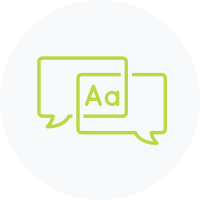The vocabulary/language mini-lessons support students and teachers with vocabulary knowledge and skills. The mini-lessons are written for specific texts, which teachers need to access for instruction. Teachers can also adapt them to other texts or even other grades. The mini-lessons cover language standards L.4 and L.5, which are the standards with greatest focus on vocabulary as it applies to reading.
| LANGUAGE STANDARD | ASSOCIATED WHEATLEY TEXTS | ASSOCIATED WHEATLEY READING LESSONS | |||||
|---|---|---|---|---|---|---|---|
| M1 | M2 | M3 | M4 | M5 | |||
| L.K.4 | Determine or clarify the meaning of unknown and multiple-meaning words and phrases based on kindergarten reading and content. | Introducing North America | 2 | ||||
| L.K.4.A | Identify new meanings for familiar words and apply them accurately (e.g., knowing duck is a bird and learning the verb to duck). | Rap a Tap Tap | 25 | ||||
Carnival of the Animals | |||||||
On the Farm The Three Billy Goats Gruff (Galdone) | 6 19 | ||||||
| L.K.4.B | Use the most frequently occurring inflections and affixes (e.g., -ed, -s, re-, un-, pre-, -ful, -less) as a clue to the meaning of an unknown word. | Helpers in My Community | 2 | ||||
A Letter to Amy | 12 | ||||||
| L.K.5 | With guidance and support from adults, explore word relationships and nuances in word meanings. | ||||||
| L.K.5.A | Sort common objects into categories (e.g., shapes, foods) to gain a sense of the concepts the categories represent. | Farm Animals | 3 | ||||
Three Little Pigs (Kliros) | 25 | ||||||
| L.K.5.B | Demonstrate understanding of frequently occurring verbs and adjectives by relating them to their opposites (antonyms). | ||||||
| L.K.5.C | Identify real-life connections between words and their use (e.g., note places at school that are colorful). | A Letter to Amy | 8 | ||||
From Sheep to Sweater | 30 | ||||||
| L.K.5.D | Distinguish shades of meaning among verbs describing the same general action (e.g., walk, march, strut, prance) by acting out the meanings. | Rap a Tap Tap | 26 | ||||
Carnival of the Animals | 32 | ||||||
The Three Billy Goats Gruff (Galdone) Why Mosquitoes Buzz in People’s Ears | 18 | – 23 | |||||
GRADE K: MODULE 1
| Rap a Tap Tap L.K.4.A |
|---|
Introduce the Vocabulary Learning Objective
Check Vocabulary Skills
Reteach
Vocabulary Exit Ticket
Reteach
|
| Rap a Tap Tap L.K.5.D |
Introduce the Vocabulary Learning Objective
Check Vocabulary Skills
Reteach
Vocabulary Exit Ticket
Reteach
|
| Carnival of the Animals L.K.5.D |
Introduce the Vocabulary Learning Objective
Check Vocabulary Skills
Reteach
Vocabulary Exit Ticket
Reteach
|
GRADE K: MODULE 2
| Farm Animals L.K.5.A | ||||||||||
|---|---|---|---|---|---|---|---|---|---|---|
Advance Preparation
Introduce the Vocabulary Learning Objective
Check Vocabulary Skills
Reteach
Vocabulary Exit Ticket
Reteach
| ||||||||||
| On the Farm L.K.4.A | ||||||||||
Advanced Preparation
A. B. C. D. Introduce the Vocabulary Learning Objective
door) Explain that this spring is a tool that can stretch and release to help things move. Check Vocabulary Skills
Reteach
Vocabulary Exit Ticket
Reteach
| ||||||||||
The Three Billy Goats Gruff (Galdone) L.K.5.D | ||||||||||
Advance Preparation
Introduce the Vocabulary Learning Objective
Check Vocabulary Skills
Reteach
Vocabulary Exit Ticket
ReteachWith expression, use the words roared and said in a sentence.
Ask how these sentences help students understand the difference between the words roared and said. | ||||||||||
| The Three Billy Goats Gruff (Galdone) L.K.4.A | ||||||||||
Advance Preparation
Introduce the Vocabulary Learning Objective
Check Vocabulary Skills
Reteach
Vocabulary Exit Ticket
Reteach
| ||||||||||
| Three Little Pigs (Kliros) L.K.5.A | ||||||||||
Advance Preparation
Introduce the Vocabulary Learning Objective
Check Vocabulary Skills
Reteach
Vocabulary Exit Ticket
Reteach
|
GRADE K: MODULE 3
| Helpers in My Community L.K.4.B |
|---|
Materials
Introduce the Vocabulary Learning Objective
Check Vocabulary Skills
Reteach
Vocabulary Exit Ticket
Reteach
|
| Letter to Amy L.K.4.B |
Materials
Introduce the Vocabulary Learning Objective
Check Vocabulary Skills
Reteach
Vocabulary Exit Ticket
What does the word spotless mean? A. red B. clean C. dark D. broken Sample Student Response: B. clean Reteach
|
| Letter to Amy L.K.5.C |
Materials
Introduce the Vocabulary Learning Objective
Check Vocabulary Skills
Reteach
Vocabulary Exit Ticket
Which choice can you describe with the word special? A. a stranger B. a plastic water bottle C. your birthday D. the road Sample Student Response: C. your birthday Reteach
|
| From Sheep to Sweater L.K.5.C |
Materials
Introduce the Vocabulary Learning Objective
Check Vocabulary Skills
Reteach
Vocabulary Exit Ticket
Reteach
|
GRADE K: MODULE 4
Introducing North America L.K.4 |
||||
|---|---|---|---|---|
Materials
Introduce the Vocabulary Learning Objective
Check Vocabulary Skills
Reteach
Vocabulary Exit Ticket
Reteach
| ||||
Why Do Mosquitoes Buzz in People’s Ears?L.K.5.D | ||||
MaterialsCreate a list of verbs of motion grouped by the categories fast or slow. (Note that each verb appears in some form on pp. 4–6 of Why Mosquitoes Buzz in People’s Ears.)
Introduce the Vocabulary Learning Objective
Check Vocabulary Skills
Reteach
Vocabulary Exit Ticket
Reteach
|
GRADE K: MODULE 5
| From Seed to Pumpkin L.K.5.B |
|---|
Materials
Introduce the Vocabulary Learning Objective
Check Vocabulary Skills
Reteach
Vocabulary Exit Ticket
Reteach
|




